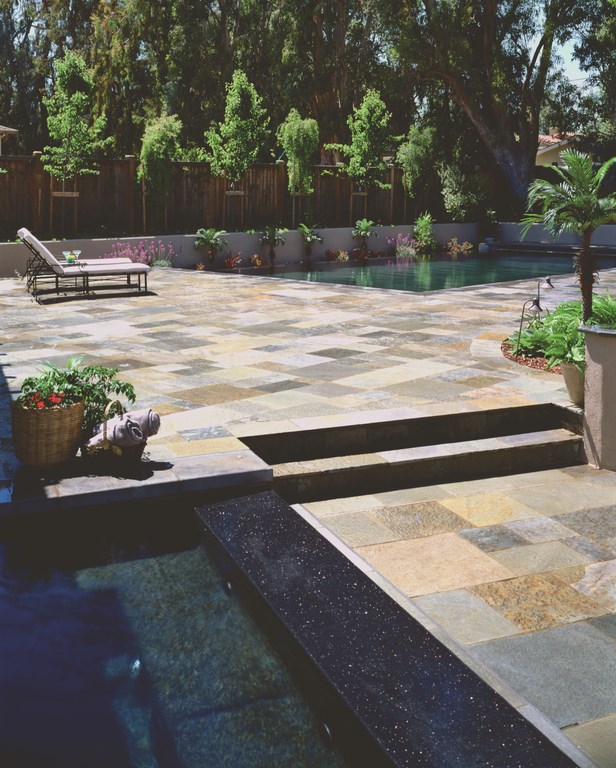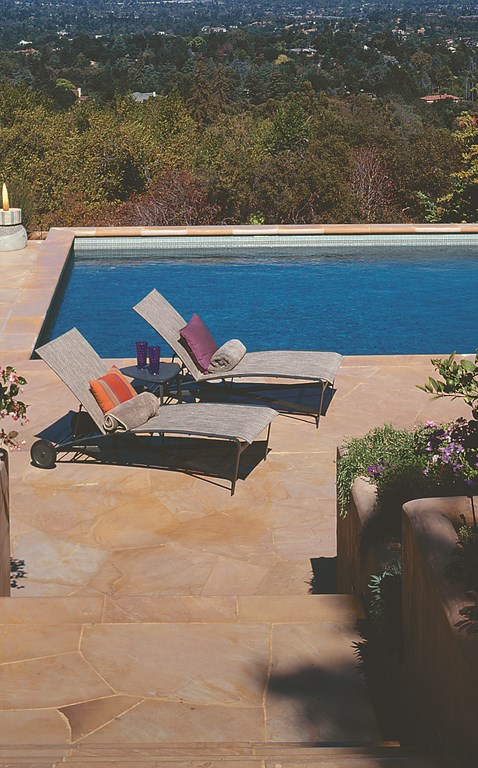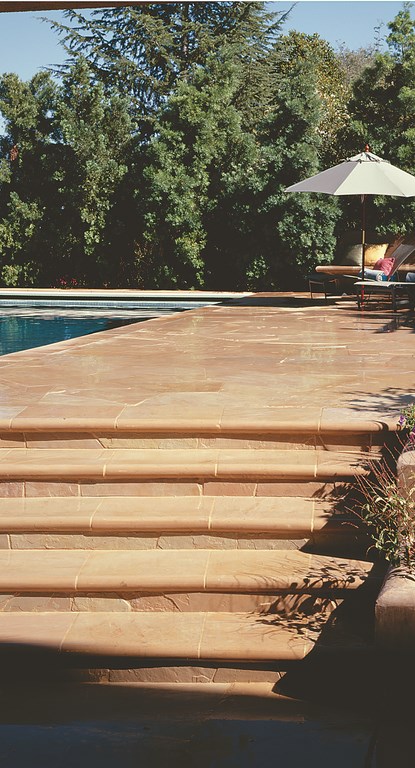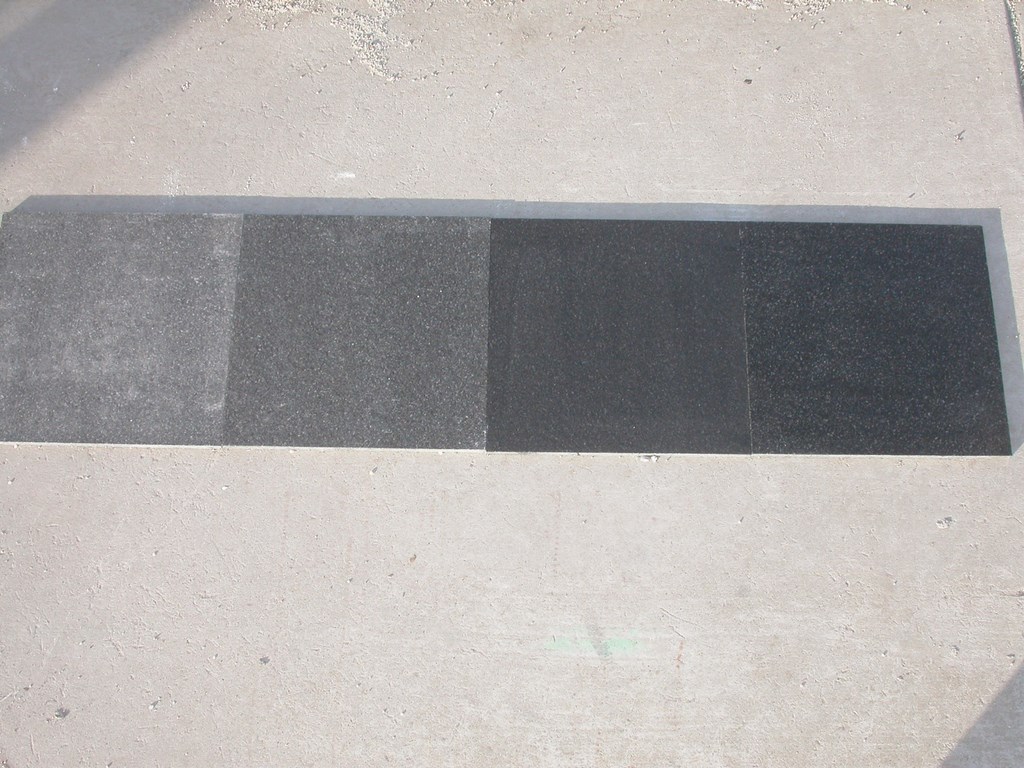Protect and Serve

| Natural stone is certainly beautiful, says watershaper Paolo Benedetti, but sustaining that beauty often means taking steps in the installation process to ensure easy maintenance and enduring protection of the stone’s exposed surfaces. Here, in the first of a series on enhancing the appearance and durability of hardscape materials found around watershapes, he takes a look at the family of chemicals designed to seal in the splendor of stone. |
By Paolo Benedetti
Few materials used in the watershaping world match the beauty, durability or luxuriousness of natural stone. It provides a rich and varied palette through a seemingly endless variety of species available from around the world, and the most common types – including granite, marble, limestone and slate – have been and are being used in a seemingly endless array of settings and applications.
Stone is so widely used and so tough a material that it’s easy to think that it will last forever without change. The fact is, however, that stone will keep its good looks for the long haul only if it has been properly installed and maintained.
Stone’s tale of enduring beauty begins when the contractor takes steps to protect it from water’s damaging effects, including stains, scale and corrosion; from the wear it will receive as a result of foot traffic, plant life and even natural erosion; and from spills that are sure to occur in recreational settings.
Ultimately, what natural stone surfaces need is a measure of contractor and homeowner awareness of the nature of the material and establishment of a proper set of cleaning practices. Even more important, these surfaces require the application of a quality sealer coat with initial installation. That’s why at our firm we’ve spent a tremendous amount of time and effort figuring out the fine points of stone sealers: Based on our experience, it’s clear that despite the added costs and labor involved in using these products, the payoff is well worth the initial investment.
POROUS NATURES
The need for sealers is driven by the nature of stone itself: Although most types appear hard and impervious, many are actually quite porous and, left unprotected, are susceptible to freeze damage, staining and decay.
By filling the pores and tiny fissures in stone, sealing provides a number of benefits including stain resistance, easier maintenance, inhibition of moss and mildew growth and protection of the stone during the grouting process.
 Without question, there’s value in the way sealers set up a barrier that prevents the penetration of spills and dirt in swimming pool areas, not to mention spills of red wine, barbecue sauce, food and greasy materials that can thoroughly mar the appearance of expensive stone.
Without question, there’s value in the way sealers set up a barrier that prevents the penetration of spills and dirt in swimming pool areas, not to mention spills of red wine, barbecue sauce, food and greasy materials that can thoroughly mar the appearance of expensive stone.
And believe me, clients are more than a bit disappointed when they learn that the spilled glass of merlot will leave behind an enduring reminder of the accident by disfiguring an otherwise beautiful limestone surface, for example. If a sealer had been used and maintained, that same errant splash of the grape would have meant no more than an easy clean up.
In the same way water beads up on the hood of a well-waxed automobile, so, too, water and spills will puddle or pool on sealed stone and will not be able to find their way into the microscopic voids that cover the surface of the stone. And let’s not single out red wine unfairly: The same benefits arise when splash out, suntan lotion, tree sap and fertilizers come in contact with sealed stone.
And where the stone itself clearly benefits, one of the best services performed by sealers has to do with grout and mortar and the way the sealers thwart mold, mildew and other unsightly blemishes to which both grout and mortar are particularly subject. In commercial settings, there’s a further benefit in that well-applied sealers can aid in the removal of graffiti and reduce the damage it can do.
Finally – and much more tangibly for contractors – there’s the assist sealers give you during the construction process. Sealing the stonework prior to grouting, for starters, helps protect the stone from the pigments in colored grout, the staining effects of gray mortar and intrusions by colored concrete. Pre-sealing also makes removing construction-related splashes and spills easy and assists in cleaning up after the grouting process.
That’s why, in my company, we seal all stonework and copings before grouting and then seal the grout as soon as it’s fully cured: It just makes sense.
WHY IT WORKS
Sealer chemistry is tremendously complex, and I won’t even pretend to completely understand the fine points. I do know, however, that on a basic level sealers form a barrier that acts as a releasing agent.
That seems simple enough, but the fact is that there are many types of sealers on the market and each of them works or purports to work in its own special way. As a rule, however, these products fall into three basic categories: penetrating sealers, surface films and admixtures added to cementitious materials such as gunite, mortar and grouts. We’ll be discussing the sealing of cementitious materials in another article in this series; for now, we’ll limit discussion to stone surfaces and to penetrating and surface sealers.
|
Outside Assistance It’s long been my contention that watershapers generally do well to reach out and consider a full spectrum of options when it comes to products such as the stone sealers discussed in the accompany feature as well as concrete admixtures, waterproofing agents, chemical stains and a host of other options. In our own work, for example, we’ve ended up turning to a set of stone-sealing products we’ve never seen on the floors at pool- or landscape-industry trade shows or in most of the trade magazines. We’ve found the journals of the concrete industry to be particularly helpful, along with information from the Portland Cement Association. Events such as the World of Concrete trade show and other construction-oriented expositions have also opened our eyes to a wide range of products we now apply in our work as watershapers. — P.B. |
Both penetrating and surface sealers use either a solvent or water as a base. The active ingredients are suspended in solutions of water or the solvent, both of which evaporate and leave the active ingredients behind to cure in or on the stone.
Recent air-quality regulations have strictly limited the use of solvent-based products, because the evaporated materials are pollutants and significant contributors to smoggy skies. As a result, most manufacturers have shifted to water-based systems that are not only environmentally friendly but also offer much easier cleanup as well as superb performance.
Solvent-based sealers were once the mainstay of the market, despite the fact that they were a little harder to apply. But now that suppliers have worked the kinks out of water-based sealers and these products do just as good a job as their solvent-based equivalents, solvent-based sealers have taken a back seat and will probably be phased out of existence before long – despite the numerous contractors who still swear by them.
Sealers are further classified in terms of aesthetics, again as three groups. There are natural-look products that have been designed not to change the appearance of the stone. There are color-enhancing agents that typically darken and enrich the color of the stone. And there are surface sealers that usually come in matte/semi-gloss or glossy. (Without special additives, the surface sealers tend to make surfaces slippery when wet. They can be used around watershapes, but only when pedestrian safety is carefully considered.)
INSIDE SCOOP
So what’s inside these penetrating and surface sealers that lets them do their jobs? Again, there are a couple of approaches and product types with which contractors should familiarize themselves:
[ ] Silicone-based sealers. Many of the products marketed as “stain-repellent” sealers use silicone. In our experience and despite their well-earned reputation as stain repellents, however, silicone-based products aren’t as effective as they need to be as stone sealers. For starters, they’re not particularly good at resisting the oily stains that come from any number of sources around a watershape, including motor oil, salad dressings, marinades, barbecue sauces, animal fats and suntan lotions.
 [ ] Teflon-based sealers. Among penetrating sealers, those containing Teflon or other similar agents (silanes, siloxanes, siliconates, epoxies, acrylic silicates and fluorosilicates) are quite effective. They all penetrate the pores of the stone and fill its capillaries. Some of these sealers also provide a molecular charge that resists staining at the molecular level.
[ ] Teflon-based sealers. Among penetrating sealers, those containing Teflon or other similar agents (silanes, siloxanes, siliconates, epoxies, acrylic silicates and fluorosilicates) are quite effective. They all penetrate the pores of the stone and fill its capillaries. Some of these sealers also provide a molecular charge that resists staining at the molecular level.
[ ] Selective sealers. Some sealers, while penetrating the stone, do not completely seal the pores. Instead, their molecular structures are sized to block the penetration of stains but to allow for the transmission of smaller water molecules. This approach works in some climatic zones, but it’s a real disadvantage in areas that experience freeze/thaw cycles where these sealers may allow destructive water to enter the stonework.
[ ] Surface-film sealers. The slippery-when-wet surface-film sealers are particularly well suited to vertical watershape surfaces made of porous, flamed, chiseled, hammered or textured stone. In glossy formulations, they create the impression that the surface is wet even when it may be dry. But this may work against the designer’s best interests at times – as when these areas are lit at night, where a glossy surface will exhibit a blinding glare.
[ ] Color-enhancing sealers. Sealers designed to build the color of stone are hybrids in that they penetrate the stone’s surface but also leave a microscopically thin film on the surface. The surface layer is designed to reflect light in a manner that causes the stone to look darker or deeper in color. The stone will be slightly slippery as a result, but at nowhere near the level found with gloss sealers.
APPLICATION SCIENCE
Through the years, we’ve picked up a few techniques in working with stone sealers that always stand us in good stead with sealer suppliers, our clients and the stonework itself.
The first rule we apply is an obvious one: We always perform a test on a sample of stone or, if none is handy, find an inconspicuous spot to conduct a test. The second rule is less obvious: Before applying any sealer to an entire project, we make absolutely certain the client is happy with the look of the sealed sample or test stone.
|
Means to Clean The cleaning products used with stonework fall into categories, just as do the sealers. In this case, there are two classes of products – the cleaners designed for routine maintenance and the strippers designed to remove the finish and give you a fresh start with the stone. * Whenever possible, it’s best to use a cleaner from the same manufacturer as the sealer that has been applied, basically to avoid problems with incompatibility. Indeed, we’ve found that the cleaners from one supplier act like strippers when used with another’s sealers – and to make matters worse, it’s sometimes hard to tell that you’ve compromised the finish! Compatibility is the key here, and you also need to make certain your clients know the score by providing them with the MSDS for any sealers used on a project along with notes on which sealers were used where. * Strippers remove the sealer or weaken its chemical bond in preparation for stonework resealing. They should be used after a cleaning product that effectively removes surface dirt and prevents its migration into the stone once you attack the sealer with the stripper. At all times, avoid the use of household cleaners on stonework, sealed or not! The compounds found in these products may stain, darken or weaken the stone or sealer, and it’s always best to work with products that have been designed and tested specifically for use with stonework. — P.B. |
Were also sticklers about surface preparation: Most sealers are applied with lamb’s wool applicators, sponges or towels to surfaces that must be clean, dry and dirt- and dust-free. If this means pressure-washing the area, letting it dry for a few days then blowing it clean with a leaf blower, so be it, because cutting corners here is asking for trouble. Indeed, residual dust, dirt or moisture can cause clouding, prevent penetration, cause spotty protection or even prevent bonding and penetration.
We also follow manufacturer directions when it comes to application of additional coats. Second applications are usually applied within 24 hours, but it’s important to know that some product labeling calls for immediate second applications while others require gaps of several days between coats.
In general, the more porous the stone, the more coats will be required to gain desired levels of protection. Granites, marbles, slates and dense limestones usually require two coats, while porous stones such as flagstone or soft limestones may need four or even five coats.
Most of the procedures outlined above are dictated by common sense and by following directions, but there’s one key path we follow that isn’t on the books: We’ve found that it is best to seal any completed stonework as projects progress rather than waiting until everything is done and can be treated all at once.
This practice has helped us avoid major catastrophes through the years, all because we’ve taken the time to sponge on a sealer right away. On one recent project, for example, a coupling on a cement-pump hose came undone during a pour. About a wheelbarrow load of colored concrete ended up being pumped onto a patch of beautiful, field-cut flagstone decking.
Everyone panicked at the time, but the flagstone cleaned up nicely with water
and a push broom, leaving no indication of the coupling blowout. Similarly, over-sprayed plaster or plaster accidentally troweled onto colored grout simply sponges off.
READ THE FINE PRINT
Beyond anything we’ve learned in the field, there’s one simple, final rule that must be followed: In everything we do with stone sealers of any type, we follow the manufacturer’s recommendations.
These directions are particularly useful in deciding which products to use on which stone. Surface sealers, for example, are designed to seal the stone by leaving a film on its surface, which means the product’s ability to bond to the surface of the stone is the key factor in successful use of the sealer.
| The various available sealers make their marks in a variety of ways to suit a range of needs. From left to right, you see the stone unsealed, then with a natural-look penetrating sealer, then with a matte surface sealer and, finally, with a glossy surface sealer. Each look has its own merits depending on the setting – and your design intentions. |
In plain black and white, for example, most surface-sealer manufacturers will advise against applying their products to polished stone because the sealer will have trouble bonding to the surface and will begin to flake, peel or cloud as the film delaminates from the polished stone.
But there are also products that bend the rules. There are glossy sealers, for instance, that make stone slip-proof. And there are penetrating sealers that enhance surface appearance, surface sealers that are invisible and other products designed to work against prevailing tendencies of products in the same categories. The only way to pick up this information is to read the labels, ask questions of your suppliers and open your mind to all sorts of possibilities that may or may not be expected based on product type.
|
Service Life Many manufacturers are now offering “lifetime” sealers that come with 10- or 20-year performance guarantees. Trouble is, most of them haven’t been around that long, so who’s to say? Manufacturers base such claims on “accelerated testing” in which samples are subjected to extreme conditions that foreshorten the timeline. These tests subject surfaces to salt-spray baths, heat lamps and deep freezes, for instance, and some involve injecting or introducing substances under pressure. Samples are then examined under a microscope to determine degrees of penetration. Even with all of this technology, no sealer should be completely trusted in the field for more than two years. We recommend checking areas with high foot traffic, for example, and then stripping and resealing as needed. Areas subject to freeze/thaw cycles may require inspections even more frequently, as sealer failure in these cases may lead quickly to cracked or spalled stonework. — P.B. |
But first things first: Rather than read every label every time you need a sealer, it’s best to start by determining what you hope to achieve with the sealer. Is it there simply to protect the stone from stains and water, or is it to add depth or richness as well as protection? Do you want the sealer to add an appearance of wetness, or is it all about protecting completed work from subsequent stages of construction? Or maybe what you really want is some assistance in retarding efflorescence?
Once you know what you’re after, you can dig into the labeling with a sense of direction and accelerate the selection process. It’s also important to know that most sealer manufacturers will give you free samples from their product lines to let you perform your own tests. We’ve always taken advantage of this service, and I’d say that through the years I’ve tested products from more than a dozen suppliers, sometimes applying them side-by-side in comparison tests.
LEARNING CURVES
To be sure, it takes time and experience to get a feel for what’s available among sealers – a process that isn’t helped by the fact that new products emerge all the time with all-new sets of performance claims that need to be tested.
|
Resources: A variety of suppliers offer stone sealers. Here’s a short list of sources that have proved reliable in helping us find the best sealers for a variety of stone applications in our watershape settings. Custom Building Products System Dynamics Inc. White Mountain Glaze ‘n’ Seal Products Stone Care International Mapei Laticrete International Miracle Sealants — P.B. |
Be that as it may, we’ve settled on a few manufacturers and seldom look much farther because we’re satisfied by the technical support they offer as well as by ready product availability and ease of application. But to reach that point, we’ve had to strip sealers, replace stonework and polish out granite – and we know most of the time that the mistakes occurred because someone did not follow directions.
I can see how this happens, because many of the materials we work with as watershapers allow us degrees of latitude in application of which we take full advantage. But with sealers, it’s amazing how important things like applying the material to clean, dry surfaces or keeping the material out of direct sunlight or applying it in proper temperature ranges can be.
We’ve also learned through experience that cost is not the driving force. We use an inexpensive spray-on penetrating sealer for concrete and grout, for example, to lend density to the surface and stop water migration and efflorescence, while we use an extremely expensive waterproofing admixture for grouts and mortars and other cementitious materials.
There’s no way around doing your homework. If you take the time to find out what works for you in your specific projects with particular types of stone in particular applications, you’ll find stone sealers that stand the test of time while adding considerable value to your projects. And isn’t it the goal of every watershaper to have stonework looking as good 20 years from now as it did the day it was installed?
Paolo Benedetti is principal at Aquatic Technology Pool & Spa, a design/build firm based in Morgan Hill, Calif. He may be reached at [email protected].











